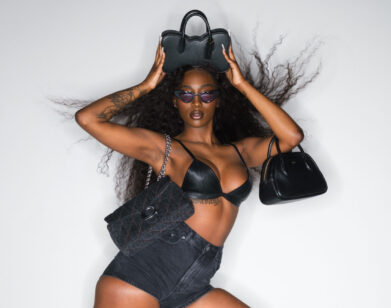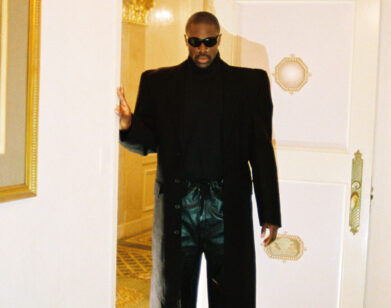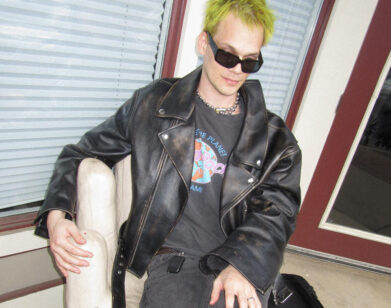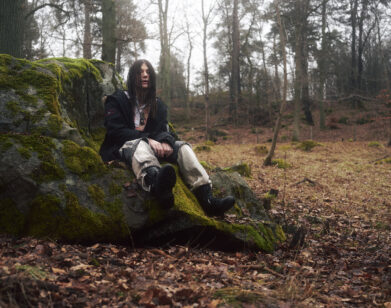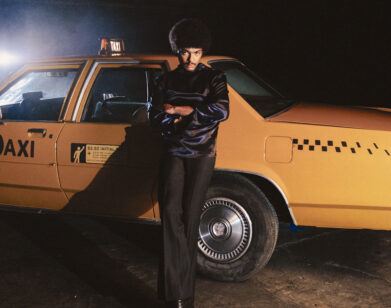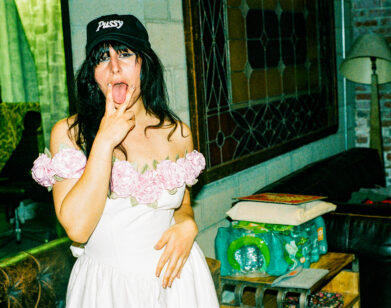Bat for Lashes: English Embrace
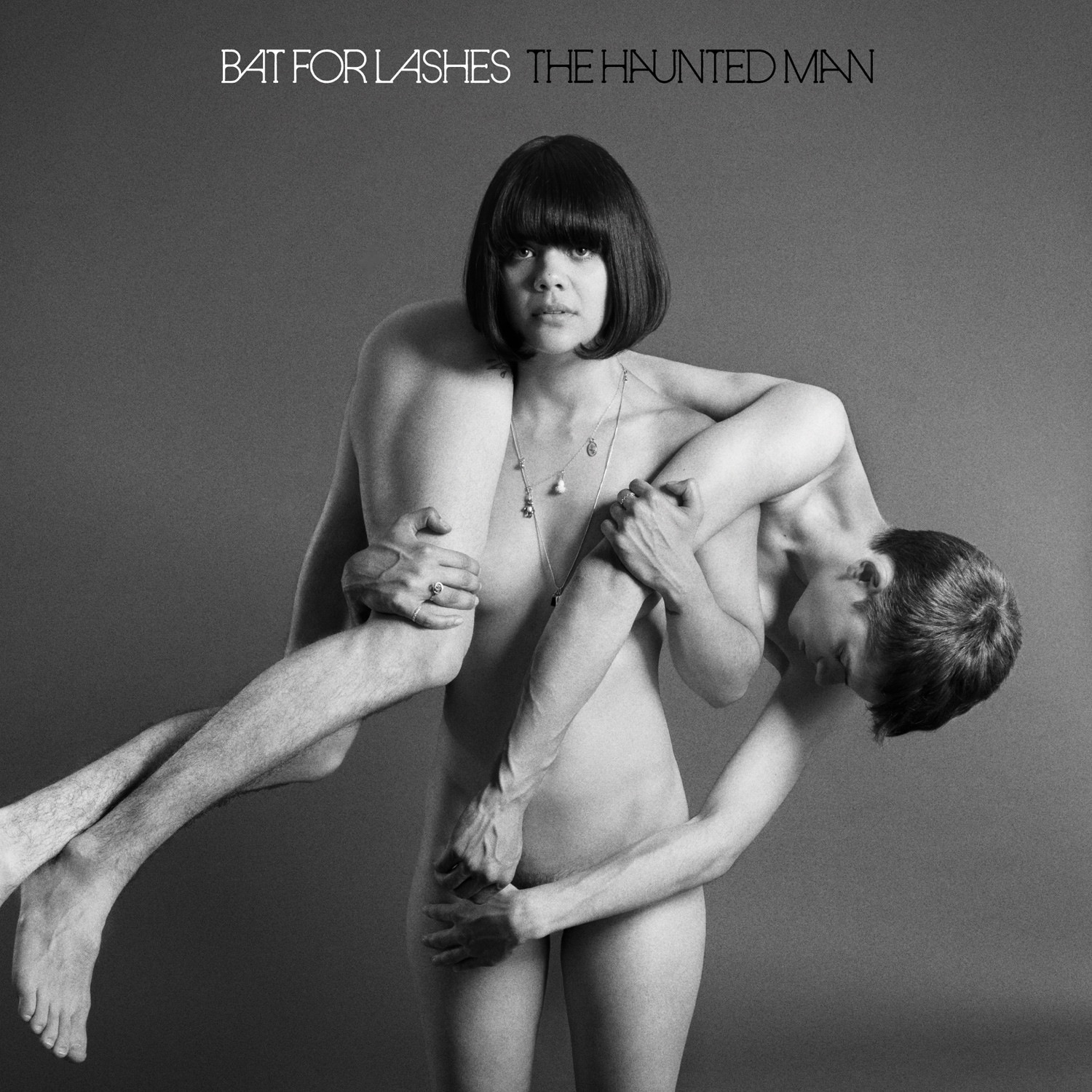
ABOVE: BAT FOR LASHES’ THE HAUNTED MAN ALBUM COVER, COURTESY OF RYAN MCGINLEY
Fantasy and a flair for theatrics has long seemed to come naturally to Natasha Khan. Bat For Lashes, since its 2007 debut Fur and Gold, has always been as much art-pop project as band, rich in characters and costumes—whether it was the more mystical aesthetic of that first release, or the bigger-sounding, pan-ethnic vibe of her 2009 breakout Two Suns, anchored by the swirling, seductive “Daniel.”
But Khan has flipped the script—to a point—on the new The Haunted Man, a record whose beauty comes partly from its relative simplicity. The album finds the artist stripped down musically—and literally, in that much-tweeted Ryan McGinley cover photo featuring Khan in her altogether, with an equally naked fellow hoisted on her shoulders. No feathers, no glitter, hair cut short, and rather than the desert hippie orientation of three years ago, a decided turn toward her roots: the rolling downs and seaside cliffs of Sussex, in the south of England. Several thousands miles west of that coast, at her publicist’s Manhattan office, we spoke to Khan about the new look and sound of Bat For Lashes.
JOHN NORRIS: It’s been quite a wait since that last record—three and a half years since Two Suns. Did you need to take that time to make the right record?
NATASHA KHAN: I think so, because the first album ran quite quickly into the second one, I kind of didn’t really have a break. So when I finally finished the Two Suns tour, which went on for quite a long time, I felt like a bit of a husk. And I remember thinking “I need to spend some time in one place, and just be at home.” So I guess the first year of that three and a half years was spent just trying to kind of get back to normal again. And when I came home, I just thought, “I’ve given out so much for so long I need to take some back in.” So I went back to my old university, and did a residency there with my old art teacher. And I live by the sea, so I spent a lot of time by the ocean, I took lots of walks. I did gardening.
NORRIS: Was that a first, or had you done it before?
KHAN: I love nature and being outside, but I specifically went to a place called Charleston House, which is in the Sussex countryside, near where I live. And it’s Virginia Woolf’s sister’s house, it’s where all these crazy artists lived, and painted everything, every surface possible. They have this Victorian walled garden, and I went and just did some gardening with Mark, the gardener, this old guy. I re-read lots of childhood books, and watched lots of films, and hung out with my family and friends, and I bought a cat. I just did really domestic stuff, because I wanted to have some life experience to write from.
NORRIS: Were you listening to new music during that downtime?
KHAN: I don’t think music is the first thing I turn to. For me, I think visual art is more the thing. Sometimes when I’ve been doing music for a while, I can’t really take any more in. So especially for that first year, it was like films, dance films, I got really into Martha Graham and Merce Cunningham, these ballet dancers. And I was watching lots of Ingmar Bergman films, a bunch of old English stuff, and old war films, reading books and poetry. I think it’s good for me to look at visual stuff, because my ears were overstimulated or something. And then gradually when I started to write songs again, I started listening to choral music and film soundtracks, stuff that was kind of like linked to the record.
NORRIS: It’s interesting that you mentioned having watched English war films, because The Haunted Man‘s title track has this snare that comes in, and there’s these guys’ voices. Maybe you can tell me a little more about it, but it’s got kind of a boys-going-off-to-war feeling to it.
KHAN: Yeah, that song to me is almost like a film in itself. In my mind, it’s like this weird wartime musical. It basically starts off very simply, with my voice just explaining how the protagonist, the woman in the song, is waiting for her husband to come back from war. And she can’t sleep because she’s convinced he’s not gonna come back. And so it’s that kind of resolution to loss I guess, and it’s pretty sad. And then slowly the snares, like you say, they come up in the mix, and these voices come. And we actually planned it to come up and over something, like a hill. So it’s like all of the soldiers are coming back from war, and then the final section is all the women are singing in response to the men.
NORRIS: And is there any reason that that became the title of the album as well? Do you feel like it in a way sets a theme for the whole record?
KHAN: I definitely think it’s a theme for the darker aspects of the record, and maybe for me it’s become apparent that the record is two halves of—it’s split into the haunted aspect of me, whether I’m haunted by the memory of someone, or a lover, or things that I find heavy, like a burden. Like the man I’m carrying on the front cover.
NORRIS: He doesn’t look that heavy.
KHAN: Well, yeah, he was the same weight as me. But he was heavy after six hours!
NORRIS: Obviously that album cover got a lot of attention when it was revealed, and the dreaded “NSFW” designation. Although I personally don’t see anything “not safe” about it.
KHAN: Yeah the reaction was kind of hilarious. I think there’s plenty R&B imagery that’s goes farther than that.
NORRIS: I know you’ve said it wasn’t about being sexual.
KHAN: No, not at all. And there were definitely sexier shots I could have chosen, where it’s more flattering to me, or like my belly button is showing and stuff. But I purposely picked that picture because it’s much more about the dynamic between me and the guy, it’s about Ryan McGinley’s photography, it’s more about harkening back to times, when people like Patti Smith and early PJ Harvey presented themselves in a very raw, wild, un-Photoshopped, un-lip-glossed, un-made-up way, kind of, “This is me.” And that’s what I did. I didn’t have any makeup on. It was very raw and natural, and I find it really interesting that people are shocked by the raw, natural representation of a woman and a man’s body. I guess it’s subverting our expectations in terms of how we’ve come to expect women to present themselves when they’re being naked. Also the woman’s and the man’s role is subverted in that image. You’d expect the man to be carrying the woman. So to me it was just a very instinctive thing, in my mind. I love Ryan, I’d seen his portraits of people with animals around their shoulders, and I thought of a man and thought “That’s what I wanna do,” he’s my soldier that’s come back from war. And Ryan was totally into it.
NORRIS: Plus, if I know anything about Ryan McGinley he knows a fair number of young guys who are light enough for you to be able to hoist onto your shoulders.
KHAN: [laughs] Yes, he knows lots of these types of people. He sent me a load of head shots and this one, Ivan, really stuck out, because he looks like the soldier in my mind that I was singing about when I wrote The Haunted Man.
NORRIS: Seeing you in such a stark black-and-white shot is also so different. Because when people think of Bat For Lashes, color is one of the first things that comes to mind.
KHAN: And adornment.
NORRIS: Exactly. And this is 180 from that.
KHAN: I think it was definitely a reaction for me, to myself. I think I always want to try and keep things interesting. So I keep taking risks and pushing myself. And I thought that I had pushed it as far as I could in terms of the glitter and the feathers and the symbolism and the objects and iconography, and having all these things around me to symbolize certain things. And I felt like I had done that to its limit. I think it is about confidence. I know that deep down inside I am quite a spiritual person. And if I strip away all of those mystical totems or whatever, does it take that away from me? No, it doesn’t. And can I still communicate something just as soulful just by being totally raw and direct and stripping everything back both musically and visually? And cutting my hair, and not wearing makeup. It’s like, what happens then? So it was almost like a test to myself, thinking how strong is my resolve inside, because that’s surely where it matters.
NORRIS: You’ve also said you wanted this record to be connected to your English roots. Did you feel like you’d gotten too far away from that with the last record?
KHAN: I got really immersed in—I love America, so I got really into being here. And a lot of my friends are from here, and they still are, but I kind of did lose my way. I felt like I lost my sense of home in a way, I guess, sort of travelling around and searching for a home with other people, but not really finding it. But then when I came back to England, it was kind of a sad time. I’d broken up with my boyfriend and everything, and I just made this decision that I need to make my own life here, and this is the place I love and where my family comes from, the English side of my family, and where I grew up. And there is something comforting about reading my old children’s books by Roald Dahl and reading English writers and watching English films and being by the coast. And suddenly I started to feel like me again. I guess that’s closer to the person who wrote the first record.
NORRIS: And the live show is going to reflect that world as well?
KHAN: Yeah I think we’ve got quite a nautical theme. Because a lot of the album is based around the coastline. For me it was very much set by the sea. And there’s waves and lighthouses and observatories. So I think we’ve got a whole bunch of old storm lanterns and some crazy old wartime radios, and I think we’re gonna get quite theatrical. And some movement, I’ve been doing lots of dance as well.
BAT FOR LASHES’ THE HAUNTED MAN IS OUT TOMORROW. YOU CAN SEE JOHN NORRIS’ VIDEO INTERVIEW WITH NATASHA KHAN THIS WEEK ON NOISEVOX. FOR MORE ON KHAN, VISIT HER WEBSITE.

